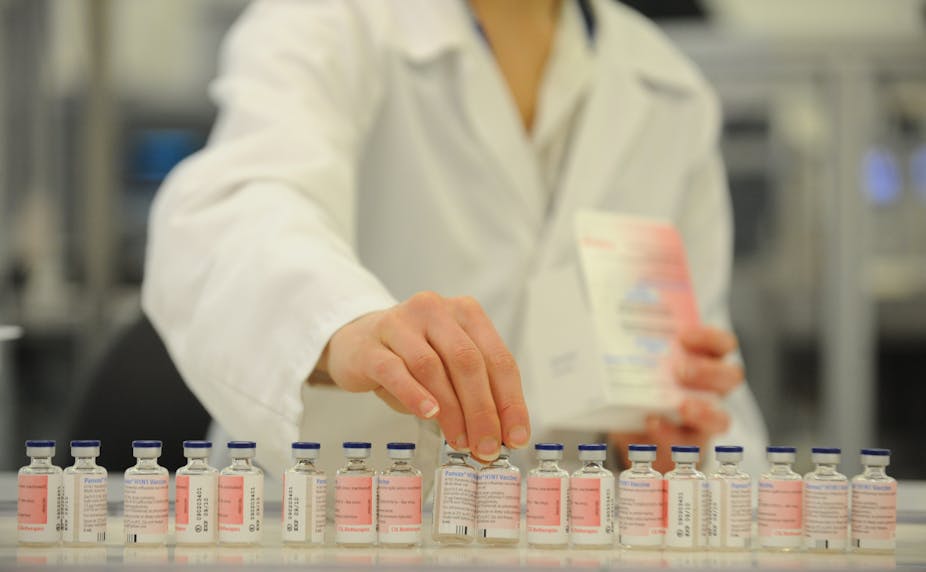A paper published in the Medical Journal of Australia today provides a possible reason for CSL’s 2010 flu vaccine causing febrile convulsions in children. The authors hypothesise that suboptimal use of the detergent called deoxycholate – used in the manufacturing process by CSL (one of the few vaccine manufacturers that use it) – to split the flu virus from its membrane may be at fault.
Professor Anne Kelso, Director of the WHO Collaborating Centre for Reference and Research in Influenza, explains the manufacturing process of flu vaccines and provides the context for understanding the authors’ hypothesis.
What goes into influenza vaccines and what’s the process of manufacturing? The paper describes CSL’s influenza vaccine as a trivalent vaccine so let’s start with that.
A trivalent influenza vaccine has three components representative of the three types and subtypes of influenza viruses currently circulating in humans. Two of them are type A viruses (subtypes H1N1 and H3N2) and one of them is a type B virus. One of the type A viruses is H1N1 2009, the virus that caused the pandemic in 2009 and has continued to circulate in humans ever since.
Most influenza vaccines are made using eggs, which are injected with the live virus. The eggs enable the viruses to grow to a very high concentration. Manufacturers then purify the virus from the eggs and inactivate it – they kill it. There are a couple of different ways that companies do that and CSL uses one of these.
The next step is to “split” this preparation of inactivated virus. This is done by adding a detergent, which in CSL’s case is deoxycholate. This step separates the proteins in the virus from the membrane component – it basically takes the virus’s skin off. What you’re left with is an enriched preparation of virus protein.
The combination of the inactivation step and splitting step ensures that there is no live infectious virus in the preparation. People may think they can get a flu infection from the vaccine but that’s not possible because of the rigor with which these processes kill the virus.
Now, after inactivation, splitting and further purification, the virus preparation is in tiny pieces and enriched in one key protein of the virus which is necessary to induce immunity to influenza.
What does this paper find was wrong with CSL’s influenza vaccine?
The paper doesn’t come from an experimental study. Rather, it reviews existing literature. The authors have analyzed information in the public domain, including previous publications from other groups and what has been reported about the issues that arose in 2010 with the CSL vaccine, which caused febrile convulsions in some young children.
They’ve developed the hypothesis that the deoxycholate used in the splitting stage may be the critical difference between the CSL vaccine and other brands of vaccine that did not cause an elevated rate of febrile convulsions.
It’s an interesting and plausible hypothesis and a worthwhile contribution to the debate. The authors have reported circumstantial evidence in its support. But it’s also important to note that the authors themselves say that it’s speculative to implicate deoxycholate.
What I think they hope to do with the paper is stimulate investigation of the possibility that deoxycholate is one of the critical factors responsible for this vaccine causing febrile convulsions.

Can CSL have been reasonably expected to know about any danger from the use of deoxycholate?
There are many steps involved in manufacturing a flu vaccine. The company will have needed to look at every step along that pathway to consider whether there was something different about the way the vaccine was made in 2010 compared with other years, or about the way the manufacturing process worked with the viruses used in that vaccine.
CSL is now beginning to report their data. Some was reported at an influenza conference in Malta this week. I don’t know whether they have considered deoxycholate.
Although there are alternatives to deoxycholate, a company can’t just play around with the manufacturing process of a registered vaccine without testing the impact to make sure the vaccine is still safe and effective in humans.
This is where the interaction between companies and regulatory authorities is critical. Regulatory authorities ask to see all the data a company has on its vaccine to ensure it has all the properties it should before they allow that vaccine to be registered for use in their country.
In Australia, the regulatory authority is the Therapeutic Goods Administration (TGA) and in the United States it’s the Federal Drug Administration (FDA).
FDA seems to have been more involved in highlighting the problems with CSL’s influenza vaccine rather than the TGA. Why is that?
The FDA places a lot of information in the public domain. We know less about what TGA has said to CSL.
Different authorities take different approaches. TGA has made announcements about these problems on its website but we don’t know what it has said to the company.
What impact do you think the paper will have?
At the end of the paper, the authors have written that the benefits of vaccination to those at risk should not be lost in this analysis and I think that’s a very important point.
A second important point is that this paper represents the scientific process at work.
We can see the value of an open and transparent scientific system where data are available to anyone in the world so we can look for patterns like the one these authors are highlighting. It may be possible over time to see links or commonalities between different events that suggest an explanation for a new problem.

